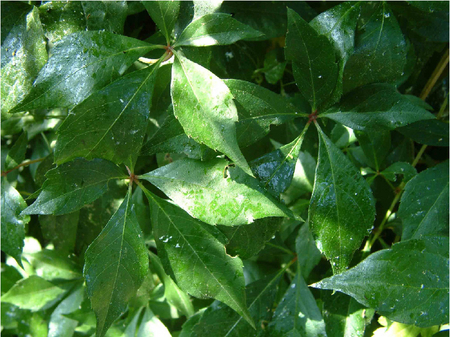Citrus flatid planthopper
Metcalfa pruinosa
Appearance
The adult reaches a length of about 8 mm including wings. Its basic color is gray-blue, which is the origin of its German name. The wings are partially covered with white wax flakes.
The larvae are whitish to pale green and are encased in conspicuous white wax filaments.
The eggs are elongated oval and measure about 0.8 mm.



Biology
The blue cicada belongs to the butterfly cicada family. To feed, the animal stings the host plants with its proboscis and sucks up the sugary plant sap transported in it. Excess sugar sap is excreted as honeydew.
Adult cicadas fly from August to late fall and lay their eggs in soft cork or cork pores (lenticels) of twigs, branches, or trunks. The eggs partially protrude into the open air. After overwintering, larvae hatch from them beginning in late May. These larvae can jump excellently. Like the adult cicadas, they feed by sucking plant juices. In the course of their development, they pass through five larval stages - in the last two, external wing systems are already visible. From about mid-July, the adult, flight-capable cicadas emerge. The blue cicada is not a vector of viruses and phytoplasmas.
Damage symptoms
As a result of the sucking activity, plant growth and the formation of fruits can be impaired. The production of honeydew with black fungi (sooty mold) settling on it contaminates the host plants and their fruits, thus reducing their quality. On ornamental woody plants, shedding remains of larvae and waxy wool lead to visual impairment.
Beekeepers are very fond of blue cicadas, as a lot of honeydew is produced in late summer when there is a high incidence of cicadas, which is excellent bee food during this period when there are few bees.



Host plants
The blue cicada has a wide host plant range. Mainly it sucks on woody plants, more rarely also on herbaceous plants. In Austria it has been found on 290 plant species so far. Some examples of strongly affected plants are:
- Maple(Acer sp.)
- Apple(Malus sp.)
- Stinging nettle(Urtica dioica)
- Blackberry(Rubus fruticosus)
- Tree of gods(Ailanthus altissima)
- Dogwood(Cornus sp.)
- Raspberry(Rubus idaeus)
- Elderberry(Sambucus nigra)
- Hydrangea (Hydrangea sp.)
- Apricot(Prunus armeniaca)
- Peach(Prunus persica)
- Currant(Ribes sp.)
- Black locust (Robiniapseudacacia)
- Bush marshmallow(Hibiscus syriacus)
- Wood vine(Clematis vitalba)
- Vine(Vitis vinifera)
- Wild vine(Parthenocissus quinequefolius)
Distribution
The blue cicada originates from North America and was first found in Italy within Europe. It has spread to Slovenia and Croatia. Regionally, it occurs in France, Switzerland, Spain, Hungary, Serbia, Montenegro, Bulgaria, Greece, Turkey and Germany. It has also been introduced into South Korea.
In Austria, the blue cicada was first found in Graz (1996) and the first mass occurrence was recorded in Vienna in 2003. Since then, the range of the blue cicada has increased, especially in the east of Austria, and there are numerous occurrences in Vienna, Lower Austria, Burgenland and Styria. Findings of the blue cicada have also been made in Klagenfurt.
Prevention and control
- Avoidance of spreading: no transports of infested plants, or such plants that are or have been in the vicinity of heavily infested plants. The risk of unnoticed carryover is particularly high, as the eggs of the blue cicada are hidden in the bark cork.
- Cut back branches during the cold season, as overwintering eggs are found on them. However, eggs are also laid on older branches and stems that cannot be cut.
- Spray treatment with agents against sucking insects (wetting agent required), (see list of plant protection products approved in Austria).
- In southern European orchards and vineyards (Italy, France, Slovenia, Croatia), the blue cicada has been controlled very successfully in a biological way for several years: for this purpose, the parasitic cicada wasp Neodryinus typhlocybae, originating from North America, is released.
- In Vienna, a small population of the cicada wasp N. typhlocybae was released in 2014 for research purposes. Previously, its host range had been studied by us in relation to native cicada species. The results of this study clearly showed that this cicada wasp is very specialized on butterfly cicadas. From this group, however, only the blue cicada occurs in Austria. Therefore, there is no risk for native cicada species.
Specialized information
Publications
Strauß, G., 2013. evaluation of potential non-target effects of Neodryinus typhlocybae, biocontrol agent of Metcalfa pruinosa, for Austria. IOBC-WPRS Bulletin, 94, 87-88.
Strauß, G., 2012. environmental risk assessment for Neodryinus typhlocybae, biological control agent against Metcalfa pruinosa, for Austria. European Journal of Environmental Sciences, 2(2), 102-109.
Kahrer, A., Strauß, G., Stolz, M., Moosbeckhofer, R., 2009. observations on faunistics and biology of the blue cicada (Metcalfa pruinosa) recently introduced to Austria. Contributions to Entomofaunistics, 10, 17-30.
Last updated: 21.08.2024
automatically translated